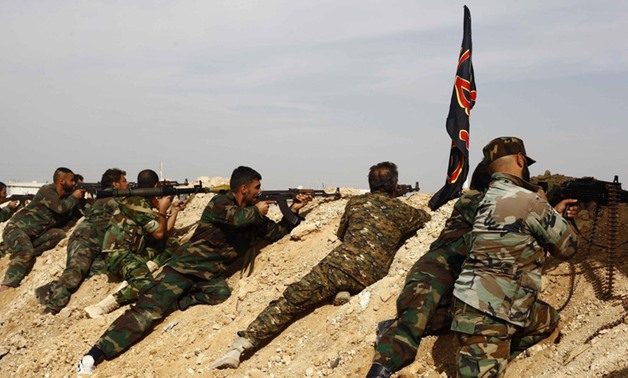
Shi’ite fighters, fighting along forces loyal to Syria’s President Bashar al-Assad, taking up position on the frontline near the Sayyede Zinab area in Damascus, Nov. 22, 2013 - Reuters
CAIRO – 19 November 2017: Moscow assures the elimination of ‘foreign forces and foreign fighters’ from a de-escalation zone in Southern Syria, following American-Russian talks in November, according to pan-Arab Asharq Awsaat newspaper on Friday.
The agreement was approved by Russia, and the U.S. while Jordan assures the withdrawal of non-Syrian fighters, in reference to Hezbollah and Iran’s forces from the de-escalation zone; representing a middle ground of five kilometers between regime forces and opposition factions.
On November 11, Russia’s Putin and U.S.’s Trump released a joint statement from Vietnam stressing the importance of reaching the ceasefire in Southern Syria that was initially agreed to in July.
The text of the agreement obtained by Asharq Al-Awsat stipulates that Russia spreads 10 checkpoints and two search points in return of a pledge from Washington and Amman to immediately work with opposition factions fighting the Islamic State (IS), Al-Nusra Front and Al-Qaeda at the separation line in the ceasefire area Southwestern Syria.
Of particular interest, the statement noted that a Memorandum of Principles on the ceasefire had been concluded in Amman, Jordan, on November 8. However, the Tripartite talks in Jordan were clearly tackling Tehran-linked militias fighting in Syria.
A U.S. official had earlier asserted that the agreement “involves Iranian forces and militias backed by Tehran, including the Lebanese Hezbollah, in addition to foreign fundamentalist militias fighting with Al-Nusra Front and other extremist groups,” Asharq Awsaat added. However, a Russian official said that such an explanation was “wrong.”
The text also asserts that no foreign intelligence is allowed in the designated “buffer zone,” based on maps attached to the text and probably located five kilometers adjacent to opposition-controlled areas in the countryside of Daraa, Sweida and Quneitra.
The tripartite agreement is based on seven principles similar to the texts of the “de-escalation zones” reached in Damascus’ Ghouta, the countryside of Homs and other areas.
The agreement, however, encompasses an item stipulating that local administrative councils remain in the area.
It also includes an item allowing the delivery of humanitarian aid and construction materials and a Jordanian pledge to open the border crossings with Syria.
Following the agreement in Amman, it became clear that U.S. President Donald Trump and Russian President Vladimir Putin met informally on the sidelines of the regional economic summit in Vietnam earlier this month and agreed to an extensive statement on the conflict in Syria. During their talk, both leaders reaffirmed their commitment to defeat IS in the country, and the need to keep existing military communications open.
The agreement includes three main principles:
1. Supporting the Geneva process and the resolution no. 2254 which includes constitutional amendments for Syria’s upcoming elections.
2. Coordination between the American and Russian armies to combat terrorism and defeat IS in Eastern Syria.
3. Implementation of the de-escalation agreement in Southwest Syria and endorsement of Amman’s Understanding Memorandum.

Comments
Leave a Comment